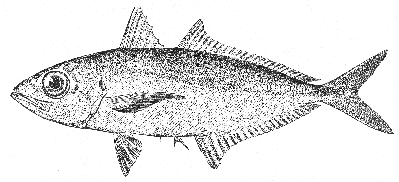Goggle-eyed scad Trachurops crumenophthalmus (Bloch) 1793
GOGGLER; GOGGLE EYE JACK
[Jordan and Evermann, 1896-1900, p. 911.]

Figure 203.—Goggle-eyed scad (Trachurops crumenophthalmus), Woods Hole. From Goode. Drawing by H. L. Todd.
Description—
This scad resembles the mackerel scad (p. 374) in general appearance, but it has larger eyes and lacks the detached finlets behind the dorsal and anal fins. Its high first dorsal fin separates it readily from the pilotfish (p. 372), while the fact that the forward half of its lateral line is only slightly arched instead of strongly so obviates any danger of confusing it with the crevalle (p. 375), the hardtail (p. 376), or the saurel (p. 377). Its first dorsal fin has 8 spines, its second dorsal is of 1 spine followed by 23 to 26 soft rays; [page 378] its anal fin has 1 spine and 20 to 23 rays, and is preceded by 2 stout detached spines. Its caudal is forked. Its ventrals originate a little behind the pectorals which reach nearly or quite as far back as its vent. Its entire breast is scaly, as are parts of its head.
Color—
Bluish above, silvery below. The fins, snout, and tip of the lower jaw have dusky markings.
Size—
Grows to a length of about 2 feet.
General range—
Cosmopolitan in warm seas, straying as far northward on our Atlantic Coast as Cape Breton, Nova Scotia.[74]
Occurrence in the Gulf of Maine—
The only positive records of this species in our Gulf are of one 5¾ inches long taken in a trap at Provincetown on August 27, 1930;[75] a second 8 miles off Chatham, Cape Cod;[76] and a third from Sandwich, on Cape Cod Bay, in the summer of 1950.[77] It may be expected to round Cape Cod from time to time, for it is taken in summer and fall as far northward and eastward as Woods Hole.
[74] Reported from Canso by Cornish, Contrib. Canadian Biol. (1903-1905) 1907, p. 85. A. H. Leim advises us that a specimen 145 mm. long was taken off Centre East Pubnico, Nova Scotia, September 12, 1951.
[75] Firth, Bull. 61 Boston Soc. Nat. Hist., 1931, p. 11.
[76] MacCoy, Bull. 70, Boston Soc. Nat. Hist., 1934, p. 6.
[77] This specimen was received from Capt. Benjamin Morrow and is now in the Museum of Comparative Zoology.